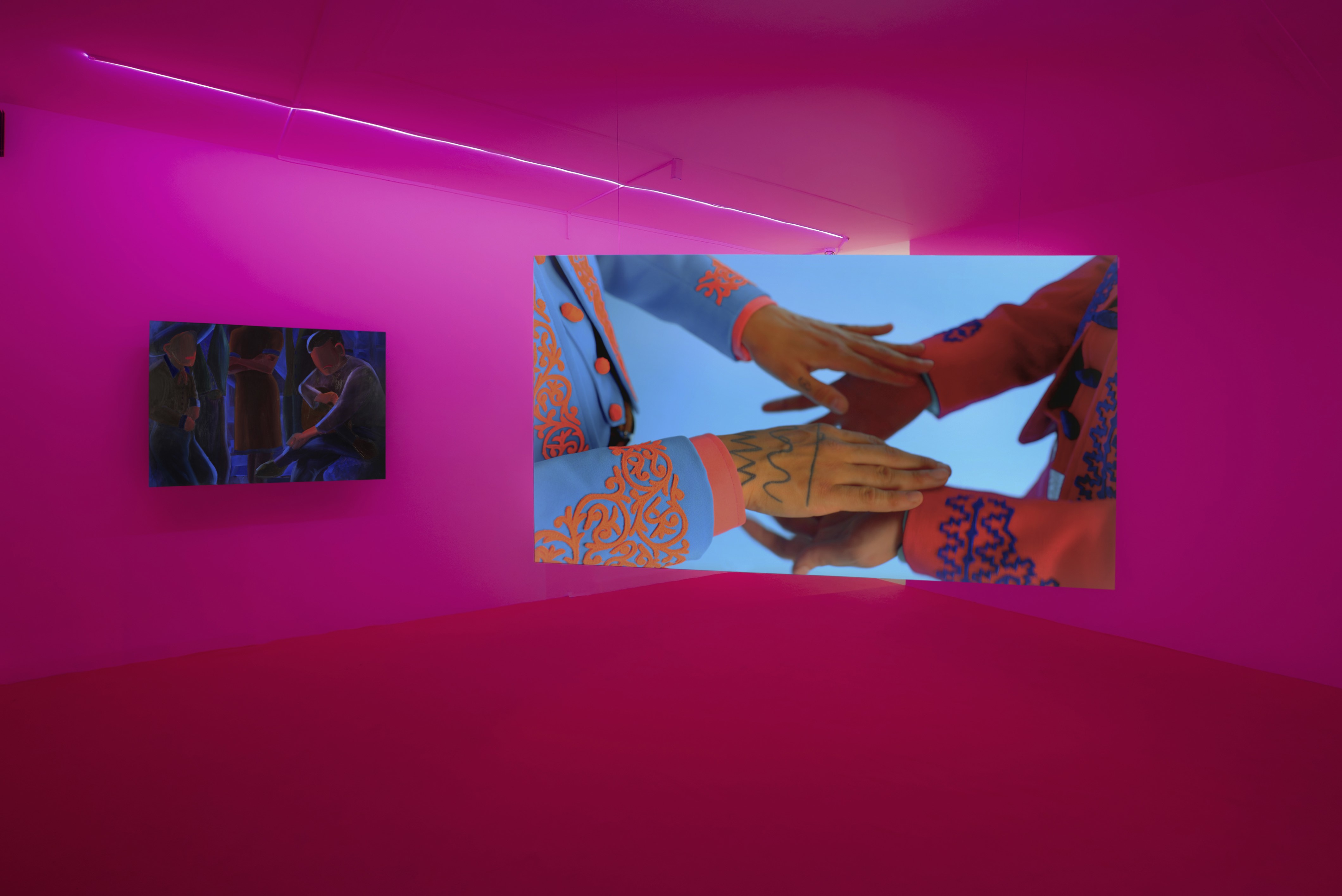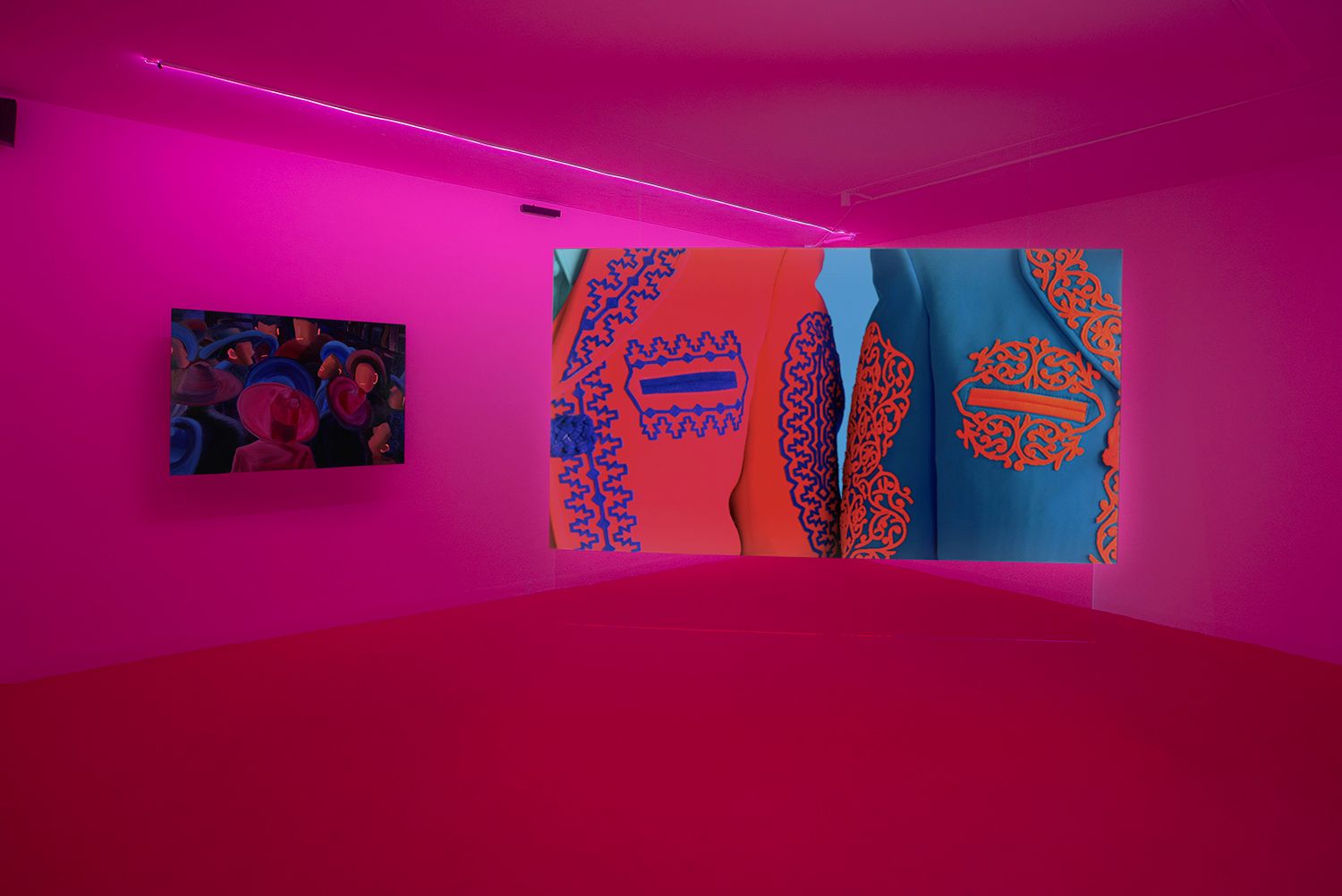
Essay
Masculinity is a Rosy Serenade: “Pos’ se acabó este cantar” by Ana Segovia
by Antonia Alarcón
At Museo de Arte Carrillo Gil
Reading time
4 min
"With this you see, Felipe, how the owner of a ranch has to be for his poor workers at once father, doctor, judge, and sometimes even undertaker. "
Don Rosendo in Allá en el Rancho Grande (Out on the Big Ranch)
INT. CANTINA. NIGHT.
We see a crowded cantina; dozens of hats flood the place. They dance as though they were floating in a lagoon. We don’t see any faces or distinguish any voices, but we know they are men. In another scene, a woman recounts, with humor, how her daughter was kidnapped at the age of 16. Then, some children greet each other, shaking hands: less to welcome each other than to prepare for a small battle. Within the narrative, small gestures go unnoticed; for Ana Segovia, they are the imprint of the structure supporting a performance of gender.
Ana Segovia is a painter of mobile images. With a base in repeated viewings of films from the Golden Age of Mexican Cinema like Allá en el Rancho Grande (1936) and Los Tres García (1946), she offers a personal method for deconstructing masculinity “itself” in that period’s performances of gender: performances we have inherited and, thankfully, have also begun to question. The artist achieves this through humor and through parodying the symbol of the charro, with his ornate clothing, his hat, and his spruced mustache; his gallantry as a way of making acceptable his macho attitudes. These elements are part of the collective imaginary, which Segovia draws on in order to explore her own interests and doubts about what masculinity means.

After traversing the various ramps of the Carrillo Gil, we immerse ourselves in the room’s pink neon light: Ana Segovia’s short film welcomes you like a hypnosis, in a sequence of repetitive actions and high-contrast colors. The piece is a commentary—as subtle as it is clear—about certain gestures and actions that identify the charro, and in which the typical characteristics of the macho unfold with the intentions of twilight: the characters get dressed, touch each other’s fabrics, slap each other continuously, break the scenery… The movements are liminal, between the violent and the sensual, the delicate and the brutal, as though the terms were no longer binary, but all things at the same time.
In Segovia’s work, the painter becomes a chromatic interpreter. The images of Golden Age cinema—in black and white—are transformed through her palette: she revamps them by colorizing them. On the other hand, the artist plays with her role as image-creator. She uses the pictorial as a creative impulse and explores the archive in order to find a new role within cinematic direction or cinematic painting. Her video functions as a moving painting or as a sequence of her paintings.

Personally, I was very grateful to be able to delve into Ana’s visual universe and to understand the origins of her concerns about macho performances in pop culture and in Mexican cinema of the Golden Age. She grew up watching these films, and had admired their protagonists since childhood, something that makes this imaginary personal for her. The songs and values represented in them sought to cement a “Mexican” identity that crosses Segovia less as a collective sign and more as an intimate symbol arising from family memory. Her work is a constant process of deconstruction of those elements belonging to her by inheritance, but that she appropriates by painting.
Tú lo dices, lo sostengo, no te vayas a cansar, no le saques, sí le saco, pos’ se acabó este cantar. (“You say it, I uphold it, don’t get tired, don’t run, I’ll run, well, this song’s done”). Upon leaving the room, I can still see figures dancing on the white walls. The charro suits are intertwined, like a ghost stationed in the eye, with the other exhibitions. Segovia’s work not only drags us into the parentheses of national cinema and the construction of masculinity, but also introduces us to an optic in which the charro becomes multidimensional and in which golden ages are covered in pink.
P.S.: Ana, I greatly connected with your personal story and I would love to recommend that you see Julio comienza en Julio (Julio Begins in July) by Silvio Caiozzi, a film that I happened to inherit because my grandparents act in it. In the film, a landowner decides to start preparing his son to be his heir and directs him towards becoming “a man.”
Translated to English by Byron Davies
The exhibition Pos’ se acabó este cantar en el Museo Carillo Gil will be open until july 25th, 2021.
Published on July 3 2021